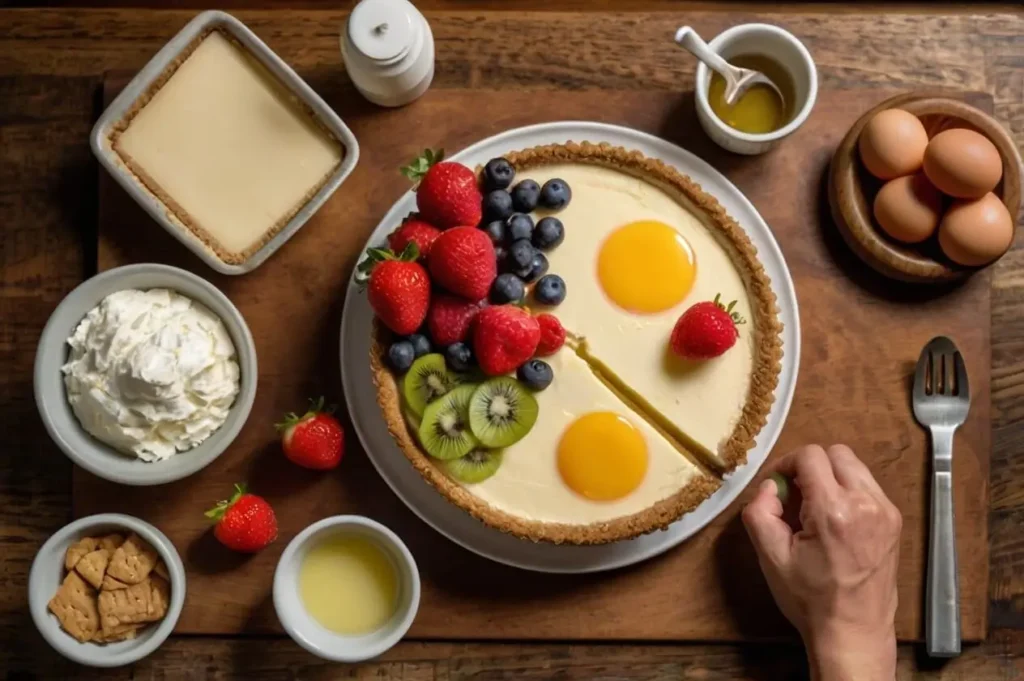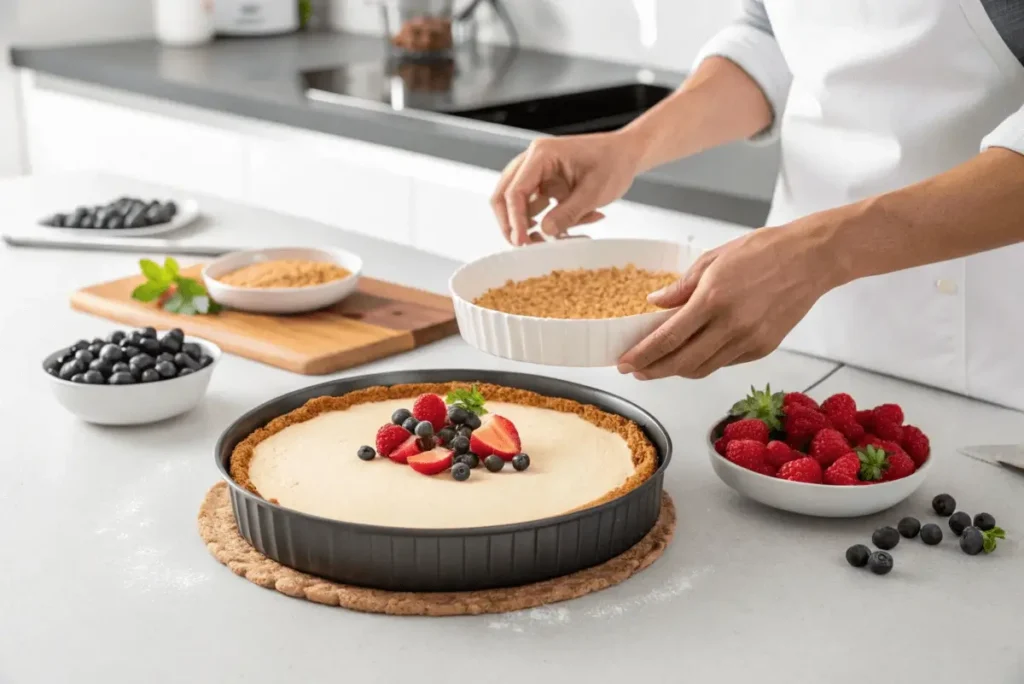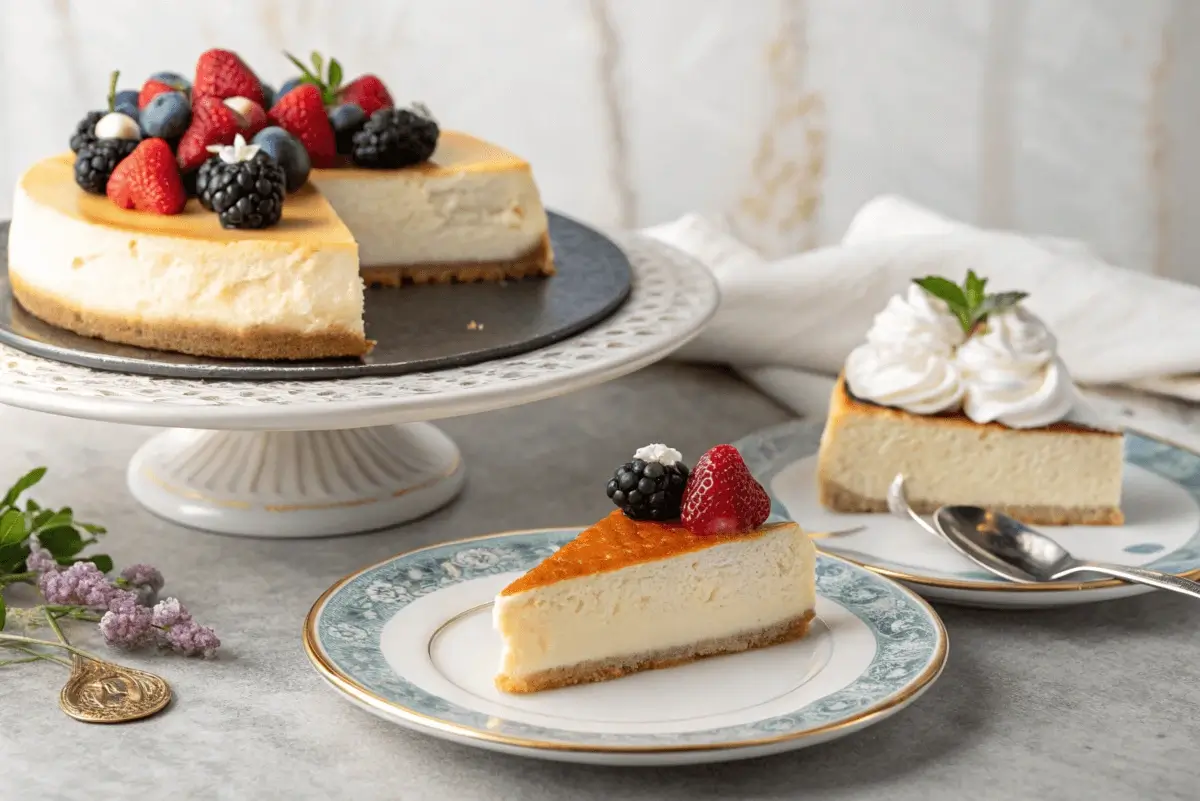Cheesecake is a beloved dessert with a rich history and an unmistakably creamy texture that captivates dessert lovers worldwide. Yet, there’s an ongoing debate among enthusiasts and bakers: is it better to bake or not bake cheesecake? Both versions have their unique appeal, textures, and preparation methods. The answer often depends on personal preferences, occasion requirements, and even your baking skills.
This comprehensive guide will explore every facet of baked and no-bake cheesecakes, from their differences to tips for perfecting each type. By the end of this article, you’ll know which cheesecake reigns supreme for your specific needs.
What is Cheesecake?
Cheesecake is a classic dessert made with a combination of cream cheese (or similar soft cheeses), sugar, and a crust—often made from crushed graham crackers or cookies. It has been enjoyed for centuries and has evolved into countless variations across cultures and regions.
Brief Overview of Baked and No-Bake Cheesecakes
- Baked Cheesecake: This traditional version involves baking a cheese mixture in the oven until set. The process ensures a dense, velvety texture with a flavor profile that’s often rich and complex.
- No-Bake Cheesecake: This simpler option relies on refrigeration to set the cheesecake. It offers a lighter, mousse-like texture, making it an excellent choice for warm climates or quick preparations.
Importance of Choosing the Right Type for Your Needs
The choice between baked and no-bake cheesecake is about more than just texture or flavor. Factors such as available time, the occasion, dietary restrictions, and even seasonal preferences can determine which cheesecake will better suit your needs.
- Hosting a summer picnic? A no-bake cheesecake can be a refreshing treat.
- Planning a holiday dinner party? The depth of flavor in a baked cheesecake could steal the show.
Understanding Baked Cheesecake
What is Baked Cheesecake?
Baked cheesecake is the quintessential version of this dessert, with origins tracing back to ancient Greece. This cheesecake requires an oven to cook the filling, ensuring it sets properly. The results are luxurious and often indulgently rich.
Ingredients Used in Baked Cheesecake

Typical ingredients for baked cheesecake include:
- Cream cheese or mascarpone
- Eggs
- Sugar
- Vanilla extract or other flavorings
- Heavy cream or sour cream (for extra richness)
- A graham cracker or shortbread crust
Baking Techniques and Equipment Required
Creating a baked cheesecake involves careful attention to technique:
- Water Bath: Most recipes recommend baking the cheesecake in a water bath to prevent cracking and ensure even cooking.
- Springform Pan: A must-have for easy removal without damaging the cake.
- Cooling Tips: Slow cooling is essential to prevent cracks and preserve texture.
Texture and Flavor of Baked Cheesecake
- Texture: Dense and creamy, baked cheesecakes melt in your mouth.
- Flavor: The baking process deepens the flavors, resulting in a more complex taste profile.
Common Types and Variations of Baked Cheesecake
Popular baked cheesecakes include:
- New York Cheesecake: Rich, tangy, and extra creamy.
- Ricotta Cheesecake: Lighter and slightly grainy, often with Italian influences.
- Chocolate Swirl Cheesecake: Decadent with a marbled chocolate layer.
Exploring No-Bake Cheesecake
What is No-Bake Cheesecake?
No-bake cheesecake skips the oven entirely, relying on chilling to set the filling. This version is perfect for beginners and those who prefer a quicker preparation.
Ingredients Used in No-Bake Cheesecake
Key ingredients for no-bake cheesecake include:
- Cream cheese
- Sweetened condensed milk or heavy cream
- Gelatin or agar-agar (for stability)
- Lemon juice (to balance the sweetness)
- Crust made of graham crackers or biscuits
Preparation Methods for No-Bake Cheesecake
The preparation involves simple steps:

- Whipping the cream cheese mixture to achieve a light texture.
- Chilling in the refrigerator for several hours or overnight to set.
- Avoiding Overmixing: Ensuring a smooth consistency without lumps.
Texture and Flavor of No-Bake Cheesecake
- Texture: Airy, mousse-like, and often lighter than baked versions.
- Flavor: Delicate, with a fresh and tangy undertone.
Common Types and Variations of No-Bake Cheesecake
Popular no-bake cheesecakes include:
- Lemon Cheesecake: Bright and zesty.
- Berry-Topped Cheesecake: Refreshing with seasonal fruits.
- Chocolate Cheesecake: Silky and indulgent.
Comparing Baked and No-Bake Cheesecakes
Understanding the differences between baked and no-bake cheesecakes is essential for making the right choice for your dessert needs. Each type has its advantages, drawbacks, and unique features that cater to different preferences and situations.
Key Differences Between Baked and No-Bake Cheesecakes
| Feature | Baked Cheesecake | No-Bake Cheesecake |
|---|---|---|
| Preparation Time | Longer (includes baking and cooling) | Shorter (requires only chilling) |
| Texture | Dense, creamy, and firm | Light, airy, and mousse-like |
| Flavor Profile | Rich and complex | Fresh and delicate |
| Shelf Life | Longer if refrigerated | Shorter due to lack of baking |
| Stability | Better suited for room temperature | Needs refrigeration to hold shape |
Pros of Baked Cheesecake
- Rich Flavor: Baking enhances the depth and complexity of flavors, making baked cheesecakes ideal for special occasions.
- Firm Texture: The combination of eggs and baking creates a smooth, dense consistency.
- Better for Layering: Holds up well with additional toppings or layered flavors, such as chocolate or caramel.
- Extended Shelf Life: Properly refrigerated baked cheesecakes can last several days without losing quality.
Cons of Baked Cheesecake
- Time-Consuming: Between preparation, baking, and cooling, a baked cheesecake can take hours to complete.
- Prone to Cracking: Improper techniques, such as skipping a water bath or rapid cooling, can lead to unsightly cracks.
- Requires Precision: Baking involves more exact measurements and techniques compared to no-bake methods.
- Less Suitable for Hot Climates: Can become too heavy for warm-weather gatherings.
Pros of No-Bake Cheesecake
- Quick and Easy: Requires minimal time and effort, making it a great choice for beginner bakers.
- Light and Refreshing: Its airy texture makes it an excellent dessert for summer or after a heavy meal.
- Flexible Ingredients: Easily adapted to dietary restrictions, including vegan or gluten-free options.
- No Special Equipment Needed: Unlike baked cheesecakes, you won’t need a springform pan or oven.
Cons of No-Bake Cheesecake
- Requires Chilling: Needs several hours in the refrigerator to set properly, which may be inconvenient for time-sensitive events.
- Less Stable: Doesn’t hold up as well at room temperature, especially in warm environments.
- Simpler Flavor: Lacks the depth and richness that baking imparts to the dessert.
- Limited Topping Choices: Heavy toppings can cause the no-bake cheesecake to collapse or lose shape.
Which Cheesecake Is Better for Different Occasions?
Choosing between baked and no-bake cheesecake often depends on the occasion, environment, and your personal preferences. Here’s a detailed guide to help you decide which type of cheesecake will shine in various scenarios.
Choosing the Right Cheesecake Based on Climate
- Warm Weather or Summer Gatherings:
- No-Bake Cheesecake: The lighter texture and chilled nature make it perfect for hot days. It provides a refreshing dessert option without heating up your kitchen.
- Tip: Add seasonal fruit toppings like berries or mango for an extra touch of summer.
- Cool Weather or Winter Holidays:
- Baked Cheesecake: The denser, richer flavors of a baked cheesecake pair wonderfully with cozy, cold-weather settings.
Cheesecake for Casual Gatherings vs. Formal Events
- Casual Gatherings:
- A no-bake cheesecake is often the best choice for informal settings. It’s quick to prepare, easy to transport, and doesn’t require intricate baking techniques.
- Pair it with simple toppings like crushed cookies or chocolate drizzle for a crowd-pleasing dessert.
- Formal Events:
- Opt for a baked cheesecake, especially when presentation and sophistication are key. Variations like New York-style cheesecake or layered options can elevate any dinner party or celebration.
Considerations for Dietary Restrictions and Time Constraints
- Dietary Needs:
- No-Bake Cheesecake: Ideal for creating vegan or gluten-free versions. Substitute cream cheese with plant-based options and use alternative crusts like almond flour or gluten-free crackers.
- Baked Cheesecake: Adjustments for dietary restrictions are possible but may require more expertise, especially when replacing eggs or dairy.
- Time Constraints:
- If you’re short on time, go for a no-bake cheesecake. With less preparation and no oven involved, it’s a time-saver.
- However, if you have the luxury of planning ahead, a baked cheesecake rewards you with its superior taste and texture.
Which Cheesecake to Serve at Popular Occasions
| Occasion | Recommended Cheesecake | Why? |
|---|---|---|
| Birthday Parties | Baked Cheesecake | Rich and celebratory, with endless variations |
| Family Picnics | No-Bake Cheesecake | Easy to make and perfect for transport |
| Weddings | Baked Cheesecake | Elegant and suitable for formal settings |
| Potlucks | No-Bake Cheesecake | Quick, versatile, and crowd-friendly |
| Holiday Dinners | Baked Cheesecake | Pairs well with festive themes |
Expert Tips for Perfect Cheesecakes
Making a cheesecake, whether baked or no-bake, can be an art form. Following these expert tips will help you avoid common pitfalls and ensure your dessert is a showstopper every time.
How to Avoid Common Baking Mistakes (Baked Cheesecake)
- Prevent Cracks in the Cheesecake:
- Use a water bath (bain-marie) to create steam and maintain even heat.
- Avoid overmixing the batter, which can introduce air bubbles that expand during baking.
- Perfect the Texture:
- Bring all ingredients, especially cream cheese, to room temperature before mixing.
- Mix at low speed to prevent over-aerating the batter.
- Bake at the Right Temperature:
- Low and slow is the key. Bake at 325°F (163°C) unless your recipe specifies otherwise.
- Cool Gradually:
- Turn off the oven and leave the cheesecake inside with the door slightly open for an hour to prevent rapid temperature changes that cause cracks.
Tips for Achieving the Ideal Consistency (No-Bake Cheesecake)
- Chill for the Right Amount of Time:
- A no-bake cheesecake needs at least 4–6 hours in the refrigerator to set fully. Overnight is ideal for the best results.
- Stabilize with Gelatin (or Alternatives):
- If the mixture seems too soft, adding a small amount of dissolved gelatin or agar-agar can provide extra stability without altering the taste.
- Whip the Cream Properly:
- Whipped cream adds lightness to a no-bake cheesecake. Whip until stiff peaks form to maintain the airy texture.
- Choose the Right Pan:
- Use a springform pan to achieve clean edges and easy removal. Line the bottom with parchment paper for added convenience.
General Tips for Both Types of Cheesecake
- Choose High-Quality Ingredients:
- The taste of a cheesecake relies heavily on the quality of cream cheese, eggs, and flavorings. Always opt for the best you can afford.
- Prepare the Crust Properly:
- Press the crust firmly into the pan and pre-bake (for baked cheesecakes) or chill (for no-bake cheesecakes) to ensure it stays intact when sliced.
- Add Flavor Enhancements:
- Experiment with extracts like almond or citrus, or swirl in sauces like chocolate or fruit puree for added dimension.
- Decorate Thoughtfully:
- Fresh fruit, whipped cream, or caramel drizzle can elevate the visual appeal of your cheesecake. Match toppings to the flavor profile for a cohesive dessert.
Pro Tip for Both Types
If you’re unsure about making a full cheesecake, try smaller portions first, like cheesecake bars or minis. This approach is more forgiving and helps you perfect your technique.
Frequently Asked Questions (FAQs)
Here are answers to some of the most common questions about baked and no-bake cheesecakes, including those you’ve provided.
Is it better to bake or not bake cheesecake?
The choice between baked and no-bake cheesecake depends on your preferences:
- Baked cheesecake offers a dense, creamy texture with a richer flavor.
- No-bake cheesecake is lighter and more refreshing, perfect for warmer weather or quick preparations.
Ultimately, there’s no definitive answer—it’s all about the occasion and your taste.
Which baking method is best for cheesecake?
For baked cheesecakes, the water bath method is the best approach. It ensures even cooking, prevents cracking, and creates a velvety texture. This method involves placing the springform pan in a larger pan filled with hot water during baking.
What is the difference between baked cheesecake and set cheesecake?
- Baked Cheesecake: Made with eggs and baked in the oven. It sets as it cools, resulting in a firm and rich texture.
- Set Cheesecake (No-Bake): Relies on chilling to firm up. The texture is softer, more like a mousse, and it’s often lighter in flavor and preparation.
Is real cheesecake baked or not?
Traditionally, cheesecake has been baked. Ancient recipes, including those from Greece and Rome, called for baking the cheese mixture. However, no-bake cheesecakes have grown in popularity due to their convenience and versatility, so they are equally valid in modern interpretations.
How do I store baked and no-bake cheesecakes?
- Baked Cheesecake: Wrap tightly in plastic wrap and store in the refrigerator for up to 5–7 days. It can also be frozen for up to 3 months.
- No-Bake Cheesecake: Store in an airtight container in the refrigerator for 3–5 days. Avoid freezing, as it can alter the texture.
Can I make no-bake cheesecake vegan?
Absolutely! Replace cream cheese with plant-based cream cheese, use coconut cream or cashews for richness, and stabilize with agar-agar instead of gelatin. Pair with a vegan crust made from crushed nuts or cookies.
Which cheesecake lasts longer?
Baked cheesecakes generally last longer due to their cooked ingredients. When stored correctly in the refrigerator, they can remain fresh for up to a week, while no-bake cheesecakes typically last 3–5 days.
Can you bake a no-bake cheesecake?
No, a no-bake cheesecake is specifically designed to set through refrigeration. Baking it would alter its consistency and likely ruin the dessert. If you prefer a baked texture, opt for a baked cheesecake recipe instead.
What toppings work best for each type of cheesecake?
- Baked Cheesecake: Dense toppings like caramel, chocolate ganache, or heavy fruit compotes complement its firm texture.
- No-Bake Cheesecake: Light toppings such as fresh fruits, whipped cream, or a dusting of cocoa powder are ideal.
Which is healthier: baked or no-bake cheesecake?
No-bake cheesecake often has fewer calories and fat due to the lack of eggs and sometimes reduced cream content. However, the health factor depends on the recipe and portion sizes for both types.
Conclusion
Cheesecake is a delicious dessert loved by many. Deciding between baked and no-bake cheesecake depends on your taste, occasion, and how much time you have.
- Baked Cheesecake: It has a rich, creamy texture and deep flavor. Though it takes more time and effort, it’s perfect for special events and holidays.
- No-Bake Cheesecake: This version is quick and easy to make. It’s lighter and great for casual gatherings or warm weather. It also works well for different diets and creative flavors.
Final Recommendation
If you’re new to making cheesecake or short on time, start with a no-bake option. Once you feel confident, try a baked cheesecake to enjoy its rich taste and creamy texture.
No matter which you choose, cheesecake is always a favorite. With these tips and ideas, you’re ready to create a dessert everyone will love.
More Delicious Recipes
- Why White Chocolate May Not Be Gluten-Free: 5 Crucial Facts to Know
What Are Black Bean Brownies Made Of?Health Benefits & Recipes
What Does Adding Coffee to Brownies Do? the Secret to Richer, More Decadent Desserts

